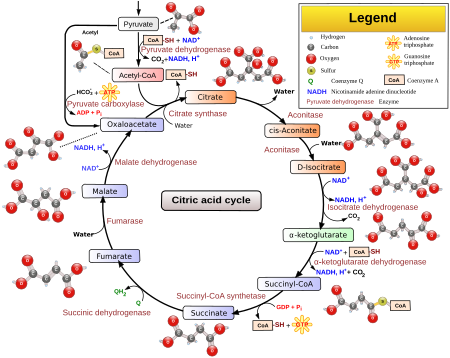FUNCTION: To produce high energy molecules such as NADH and FADH2, which act as electron carriers in the electron transport chain. The ETC is where most of the cell's ATP (energy currency) is produced. Additionally, many different precursor molecules are made that can be utilized by a cell.
The Krebs cycle is what is known as Amphibolic, in that it is both catabolic (breaks down molecules) and anabolic (builds molecules).
LOCATION: Mitochondrial matrix
NET PRODUCTS: 2 GTP, 6 NADH, 2QH2 (ubiqinone), 2 FADH2, 2 CO2, minimal ATP
Step 1. Pyruvate molecules (3-carbon) from glycolysis are converted into another type of molecule called Acetyl-CoA in a process known as pyruvic oxidation. This conversion occurs when the pyruvate is broken down by an enzyme, releasing a carbon atom which goes on to form carbon dioxide (CO2). The 2 remaining carbon molecules bond with coenzyme A forming Acetyl-CoA. During this process, electrons and a hydrogen ion are passed to NAD+, thus oxidizing the pyruvate, hence the name of the process.
Step 2. The Acetyl-CoA then enters the Krebs cycle. It initially combines with a 4-carbon molecule called oxoaloacetic acid, forming a 6-carbon molecule of citric acid (citrate). This reaction is catalyzed by the enzyme citrate synthase. Upon this formation, the coenzyme A is released.
Step 3. The citrate molecule is then dehydrated (H20 molecule is removed) and then rehydrated by the the enzyme aconitase. The resulting molecule is just a rearranged form of citrate known as isocitrate.
Step 4. Next, isocitrate undergoes what is known as a oxidative carboxylation, which simply means that a carbon and hydrogen are given off. The result of this is a 5-carbon molecule called alpha-ketoglutarate. This process is catalyzed by the enzyme isocitrate dehydrogenase. Additionally, the carbon that broke off forms CO2, while the hydrogen reduces NAD+ to form NADH.
Step 5. In the next reaction, alpha-ketoglutarate has yet another carbon molecule removed and is then transferred to a CoA molecule by the enzyme alpha-ketoglutarate dehydrogenase. The resulting product is a 4-carbon molecule of Succinyl-CoA. Additionally, CO2 and NADH is formed.
Step 6. After succinyl-CoA is formed, the molecule then undergoes the removal of the CoA carrier, resulting in the production of succinate. Additionally, the enzyme succinyl-CoA synthetase that removes the CoA also produces GTP through substrate level phosphorylation (phosphate molecule directly added to another molecule). GTP is a high energy molecule similar to ATP.
Step 7. Next, succinate is dehydrated by the enzyme succinate dehydrogenase. The resulting product is furmate.
Step 8. Furmate is then hydrated by enzyme furmase to form malate.
Step 9. Lastly, the malate is dehydrogenated by the enzyme malate dehydrogenase, forming the original molecule oxaloacetate. From this reaction, NADH and H+ are also produced.
Once the oxaloacetate molecule has been regenerated, the Krebs cycle can repeat. With the completion of this cycle, the electron transport chain (ETC) and subsequent oxidative phosphorylation occurs, resulting in the production of 36-38 ATP, providing the cell with energy.
